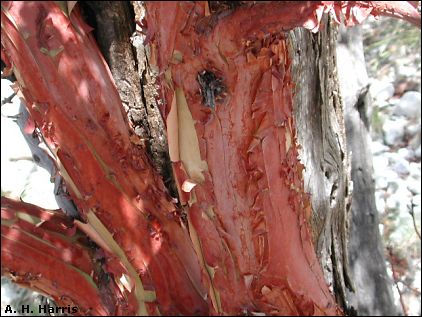
Vegetation changes rapidly as one climbs from the intermontane basin floors of the Chihuahuan Desert into the desert mountains. As a person reaches the pygmy-forest zone in highlands above the western desert, the Arizona Madrone appear. In the east, it is the Texas Madrone. Both also are known as Madroño. Other names used in Texas are Lady's Leg and Naked Indian, presumably named for the smooth, pinkish bark that matures to a deep reddish brown.
Much of the character of this small tree lies in its trunk and
branches, for the bark peels off randomly in thin layers. The result is a patchwork of
different shades, from nearly white to dark reddish, with no two trees being exactly
alike. Clusters of small, urn-like flowers appearing in spring are replaced by red
berries in due time, much to the delight of birds and mammals that feed extensively on
them. The wood of the Texas form is easily worked and possibly has some minor
commercial value; in contrast, there is no doubt whatever of the value of its
beauty.
![]()
Contributor: Arthur H. Harris, Laboratory for Environmental Biology, Centennial Museum, University of Texas at El Paso.
Desert Diary is a joint production of the Centennial Museum and KTEP National Public Radio at the University of Texas at El Paso.

Bark of Madroño, Guadalupe Mountains National Park. Photograph by A. H. Harris.